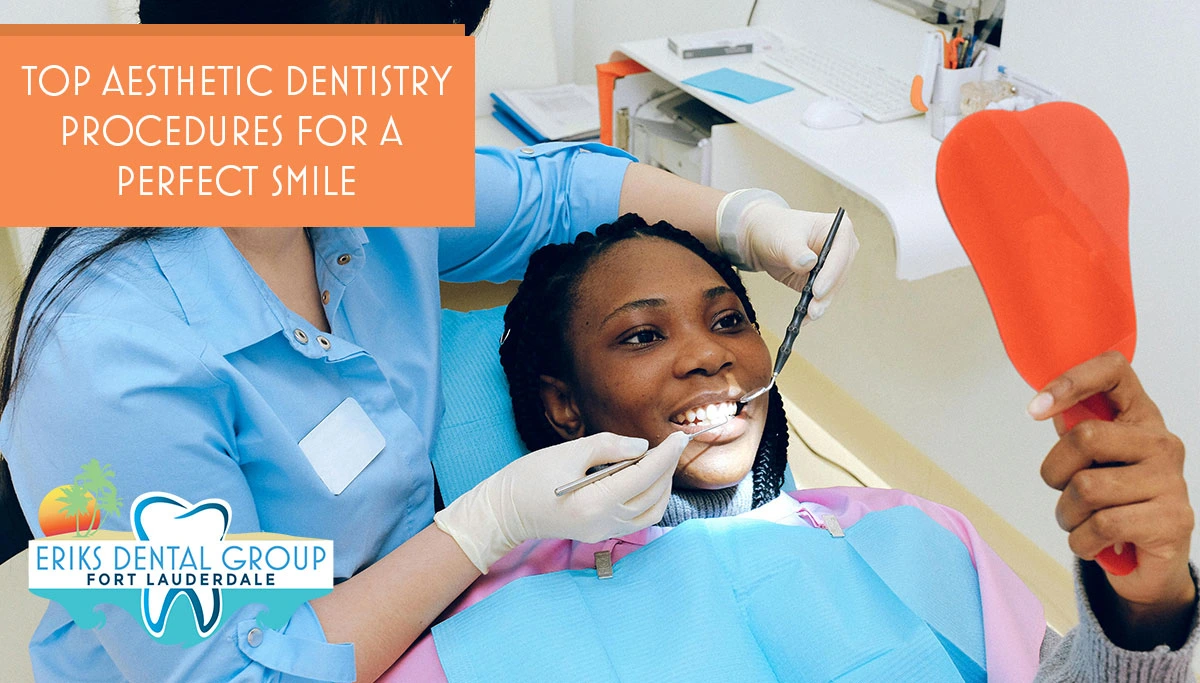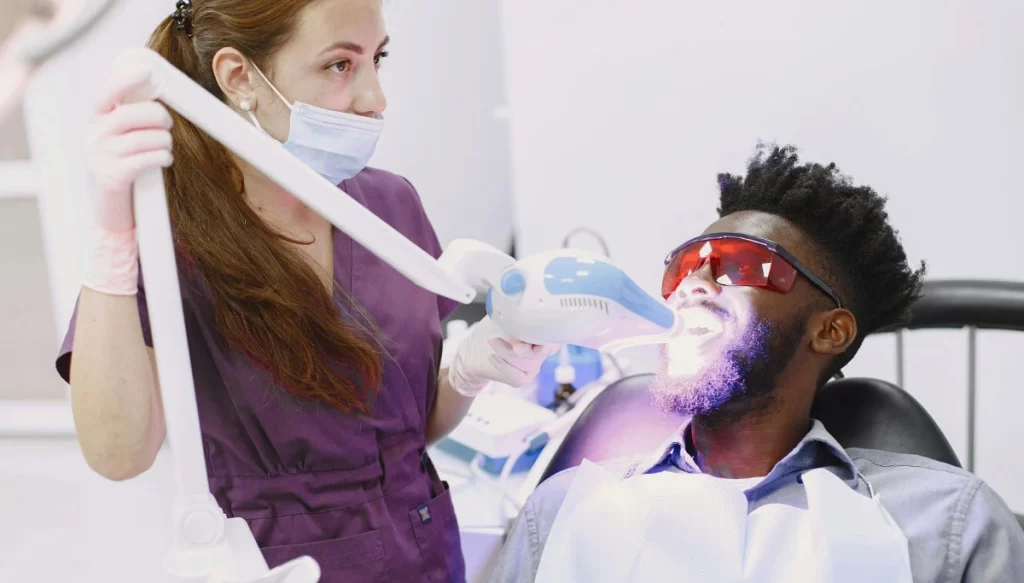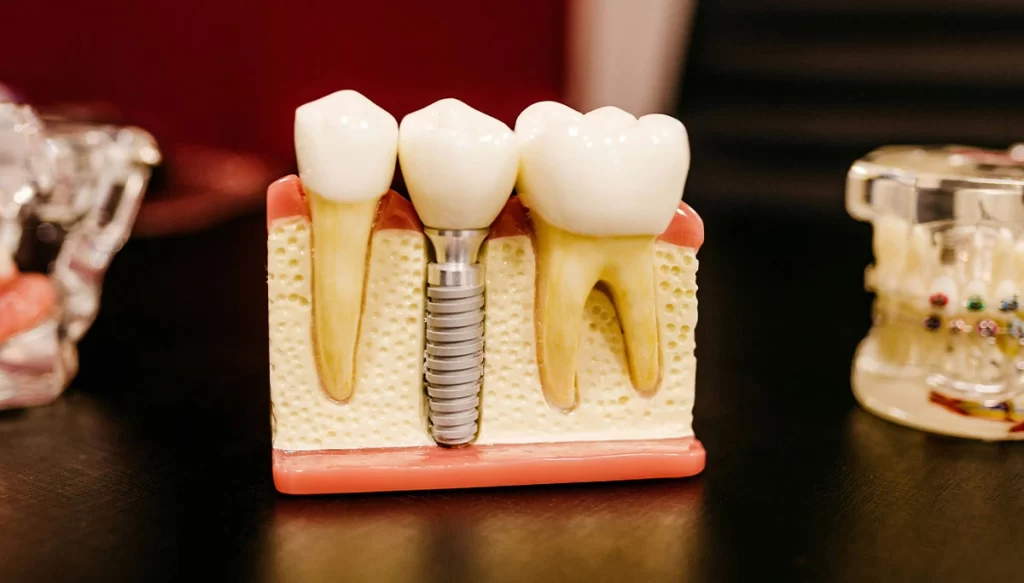
A beautiful smile can warm up a room and leave a lasting impression and aesthetic dentistry can help you achieve a beautiful, confident smile. This branch of dentistry focuses on enhancing dental aesthetics in color, position, alignment, size, and shape and aims to improve the appearance of gums, teeth, and bites.
Your dentist can recommend aesthetic dentistry if you have discolored teeth, cracked teeth, gaps between teeth, crooked teeth, uneven gum lines, or missing teeth. These procedures are ideal for those seeking a smile makeover.
Discover the different procedures of aesthetic dentistry and what they can help with:

Teeth whitening is a popular aesthetic procedure to help you achieve pearly white teeth. Dentists use teeth whitening technology and high-quality whitening products. The procedure involves placing a protective shield over gums to prevent any potential damage from the whitening solution. A hydrogen peroxide gel is applied, and an LED light is used to activate the gel that removes discolorations on the enamel.
Professional teeth whitening gives patients an effective and long lasting result than over-the-counter products which may be convenient but are often only a temporary solution.
Teeth whitening transforms stained or discolored teeth caused by two main factors:
Extrinsic discoloration is caused by:
Intrinsic discoloration can be caused by:

Invisalign is an alternative to traditional braces that realigns teeth to improve their structure and functionality. This treatment involves the use of visible, removable aligners that straighten teeth. As the name suggests, Invisalign is virtually invisible and is removed when brushing, eating, or drinking.
When you go for Invisalign treatments, the dentist uses a 3D scanner to identify your dental issues, such as crooked teeth, overbite, or underbite. Using the images taken by the scan, Invisalign aligners are customized and trimmed to fit your gum perfectly without causing any discomfort. You are expected to wear your aligners daily and consistently until you start to realize results. The treatment length varies depending on the complexity of your dental issue but, on average, takes 6 months.
You will need to visit your dentist regularly for progress monitoring, new aligners when necessary, and to address any inquiries you may have during your treatment journey.

Missing teeth can affect functionality and smile appearance. Dental implants are an ideal solution as they are artificial tooth roots surgically inserted into the jawbone to enable tooth replacement. The implant integrates with the surroundings over time, after which a bridge or crown is customized to restore the feel and appearance of a natural tooth. Implants can help prevent bone loss, improve speech and chewing, and enhance your overall smile.
Also known as dental caps, dental crowns are covers that assume the shape of a tooth to conceal broken teeth or those that have undergone root canal procedures. Crafted from a unique set of materials, dental crowns blend to match the contour and color of natural teeth.
Depending on your customization preferences, dental crowns can be metallic, ceramic, a mix of metal and ceramic, or porcelain. They are ideal for restoring the look, shape, size, and strength of teeth to enhance your smile.
Dental veneers are thin shells made of composite resin or porcelain and customized to fit over the front surface of your teeth. They address dental problems like misaligned, discolored, cracked, chipped teeth or gaps between teeth. Veneers can greatly improve your smile as they perfectly camouflage your dental flaws.
There are different types of veneers depending on your goal and include:
To increase the durability of your treatment, avoid biting crunchy or hard foods like ice, hard fruits, nuts, and hard candy. Also, avoid dark-colored food to maintain the pearly white color of your veneers, enhancing your smile.

Different dental cosmetic procedures address different dental issues. If you’re seeking aesthetic dentistry, consult your dentist on the most appropriate ones for you. They not only recommend a suitable option but also explain the benefits and risks associated with each to help in your decision-making.
If you’re in Fort Lauderdale, Eriks Dental Group can help restore your smile through our various aesthetic dentistry treatments. Whether you want whiter teeth, re-aligned teeth, dental cleanings, or a smile makeover, visit us for an extraordinary dental experience and remarkable results.
Contact us today at (954) 463-5051 or request an appointment online for compassionate, skilled and comprehensive dental services.
© 2025 Eriks Dental Group - Fort Lauderdale - All Rights Reserved. Dental Website Design by Connectica